Last updated on
Discover effective methods to prevent your couch from sliding on your wood floor, ensuring a safe and comfortable living space.
Are you tired of constantly having to readjust your couch on your slippery wood floor? Do you find yourself constantly sliding around and never feeling quite comfortable on your furniture? If so, you’re not alone. Many homeowners struggle with keeping their couches in place on a smooth surface.
But fear not, there are simple solutions to this common problem that will keep both you and your furniture firmly in place. In this article, we’ll explore some effective tips and tricks for keeping your couch from sliding on a wood floor, so you can finally relax in peace without worrying about any unexpected slips or slides.
Key takeaways:
- Non-slip couches prevent accidents and scratches on wood floors.
- Prepare hardwood floors by cleaning and applying anti-slip coating.
- Arrange furniture layout to provide stability and avoid tilting.
- Regular maintenance includes cleaning, checking legs for damage.
- Use furniture grippers, non-slip pads, coasters, or area rugs.
Table of Contents
Importance of Non-Slip Couches
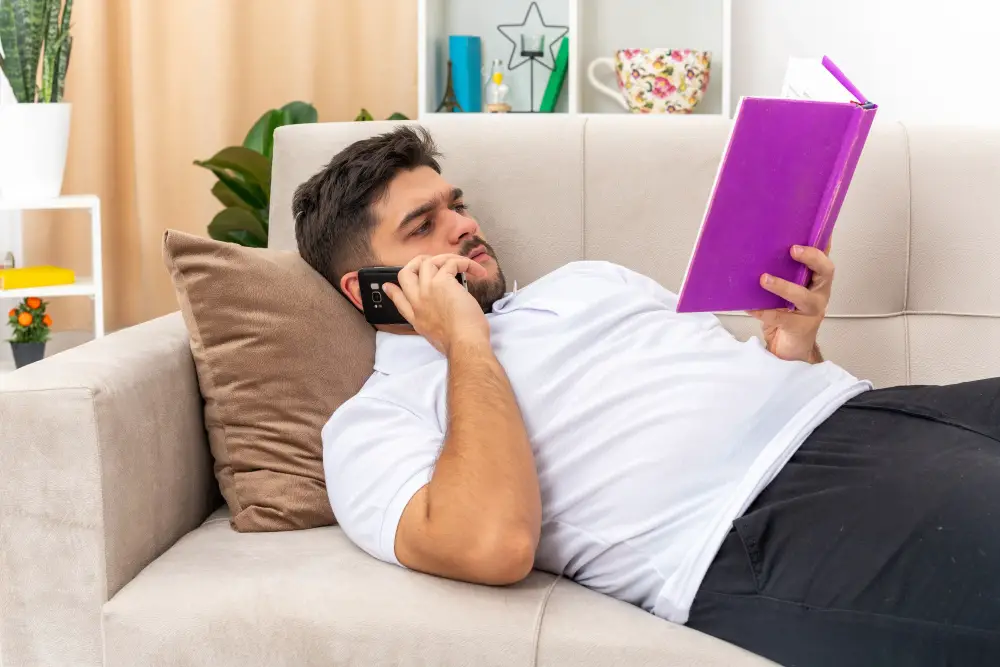
Not only does it prevent accidents and injuries, but it also ensures that your furniture stays in place and doesn’t cause any damage to your flooring. A sliding couch can scratch or dent the wood floor underneath, which can be costly to repair.
Constantly having to adjust the position of your sofa is not only frustrating but also time-consuming. By investing in non-slip solutions for your furniture on hardwood floors, you’ll save yourself from these headaches while creating a safer living space for yourself and others who use the room regularly.
In this article we will explore some effective ways of keeping couches from sliding on wood floors so that you can enjoy peace of mind knowing that both you and your furniture are safe at all times!
Preparing for Hardwood Floors

This will ensure that you have a smooth and even surface to work with, which can make all the difference in preventing furniture from slipping around.
Start by thoroughly cleaning your hardwood floors with a broom or vacuum cleaner. Make sure there is no dirt or debris left behind as this can cause unevenness and affect how well any non-slip solutions work.
Next, consider applying an anti-slip coating to the floor itself. There are many products available that create traction on slippery surfaces without damaging them.
These coatings come in various forms such as sprays or liquids and are easy to apply yourself.
Furniture Layout Tips
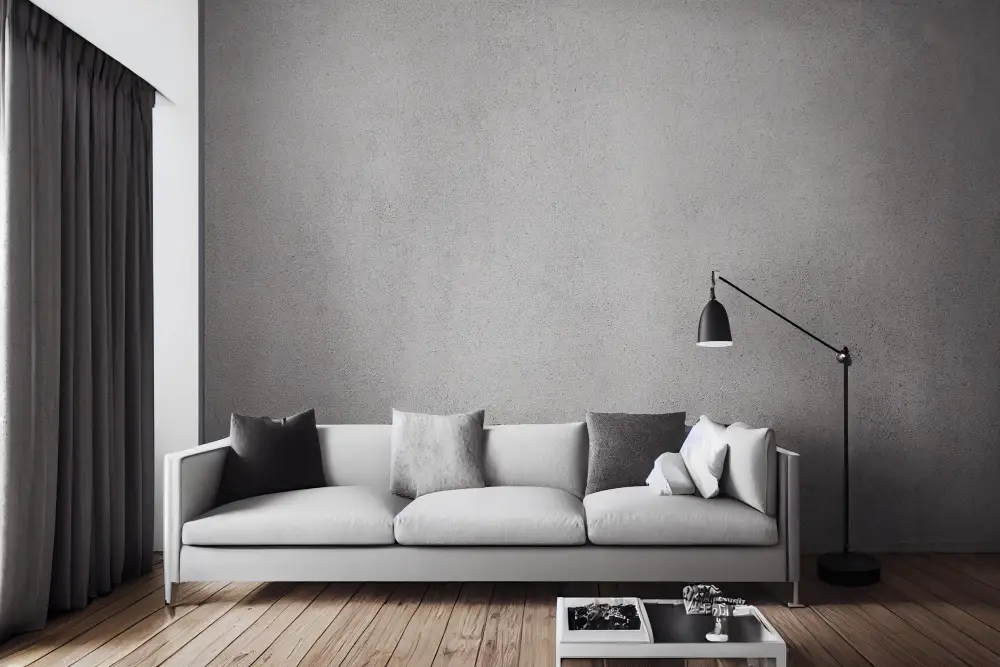
When arranging your living room, consider placing the couch against a wall or corner to provide additional support and stability. This will help prevent any unwanted movement when sitting down or getting up from the couch.
Another tip is to avoid placing heavy objects on one side of the couch, as this can cause it to tilt and slide off balance. Instead, distribute weight evenly by adding decorative pillows or throws on both sides of the sofa.
If you have other pieces of furniture in close proximity to your couch such as coffee tables or end tables, make sure they are not too close that they bump into each other causing instability for either piece.
Regular Maintenance
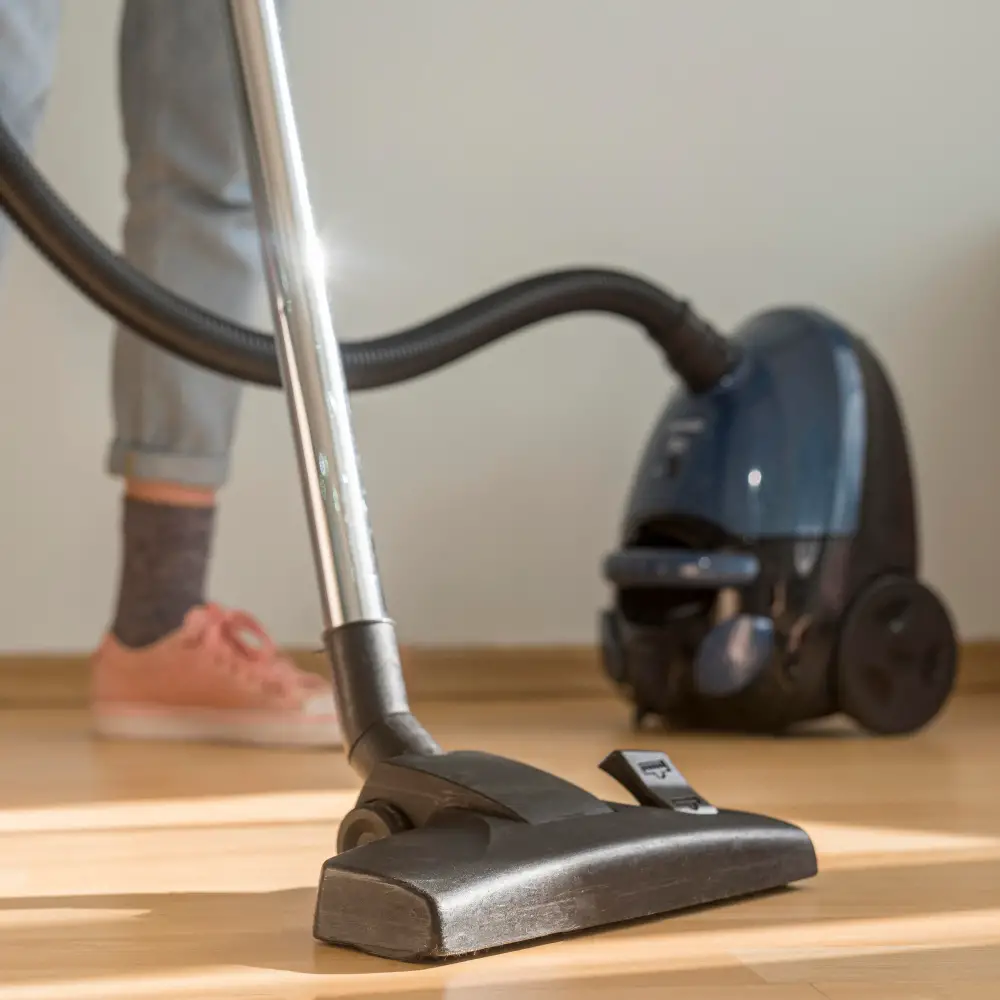
This means keeping your floors clean and free of debris, as well as regularly checking the legs and feet of your furniture for any signs of wear or damage.
Dust, dirt, and other particles can accumulate under furniture legs over time, causing them to become unstable or uneven. To prevent this from happening, it’s essential that you sweep or vacuum around your couch at least once a week.
Be sure to inspect the feet and legs on a regular basis for any cracks or breaks in their structure. If you notice any issues with these parts of your furniture piece(s), consider replacing them immediately before they cause further damage.
Regular Dusting and Cleaning
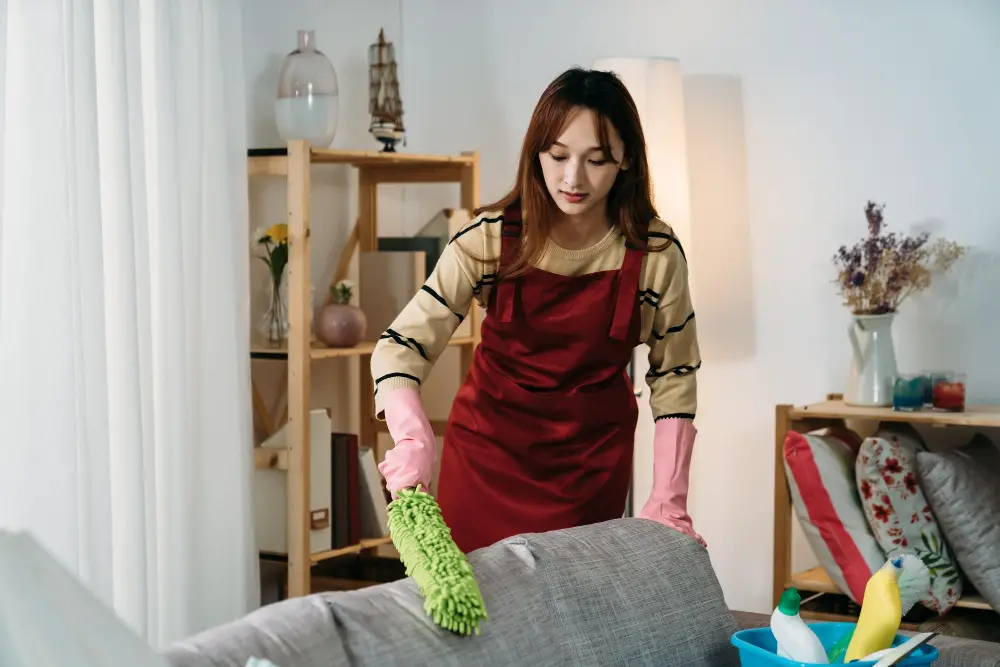
Regular dusting and cleaning can help remove any dirt or debris that may be causing your furniture to slide around. Use a soft cloth or microfiber duster to gently wipe down the legs of your couch, as well as any other areas that come into contact with the floor.
Make sure you’re using appropriate cleaning products for both your furniture and flooring type. Avoid using harsh chemicals or abrasive cleaners that could damage either surface.
By taking these simple steps, you’ll not only keep your couch in place but also maintain its appearance over time.
Furniture Grippers
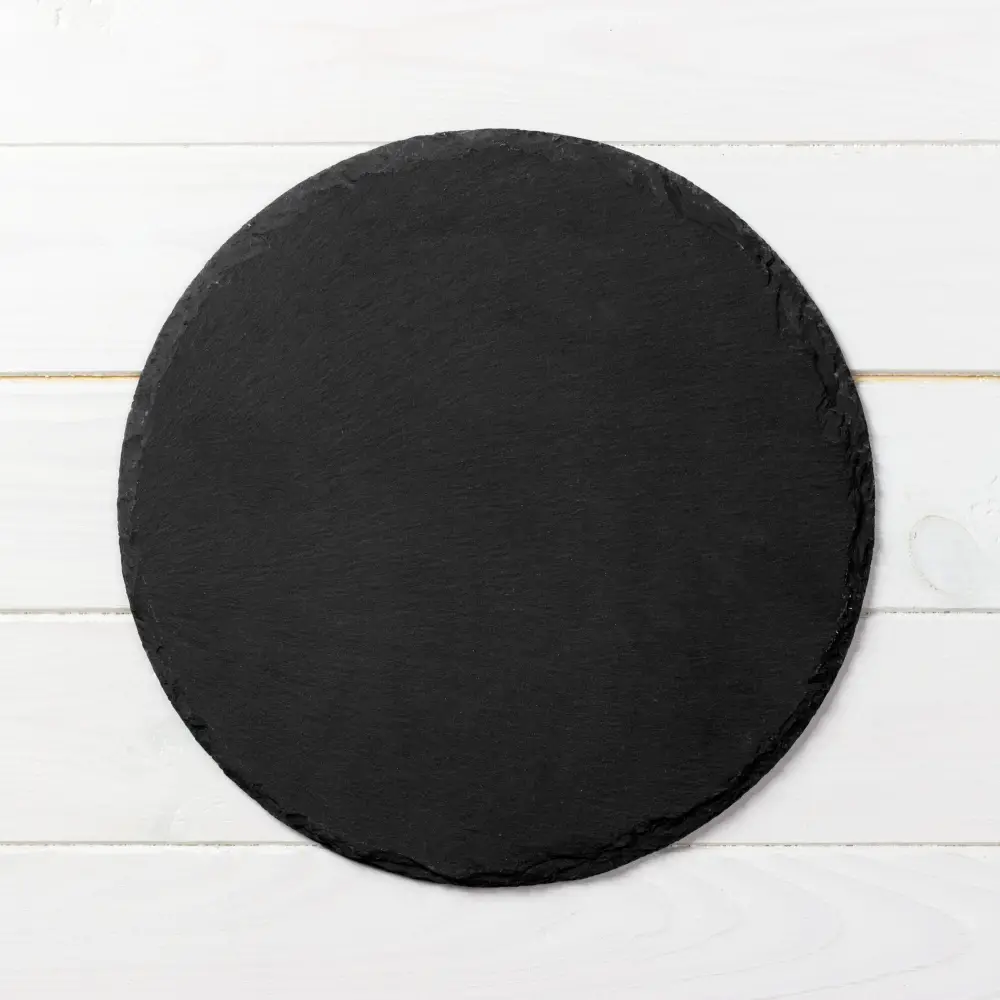
These small, adhesive pads attach to the bottom of your furniture legs and provide a non-slip surface that keeps everything in place. They come in various shapes and sizes, making them suitable for different types of furniture.
When using Furniture Grippers, it’s essential to ensure that they’re placed correctly under each leg of the couch. This will prevent any wobbling or unevenness caused by incorrect placement.
One advantage of using Furniture Grippers is their affordability and ease-of-use compared to other solutions like rubber stoppers or padding. They also don’t require any special tools or installation procedures; you can simply peel off the backing paper and stick them onto your furniture legs.
Non-Slip Pads
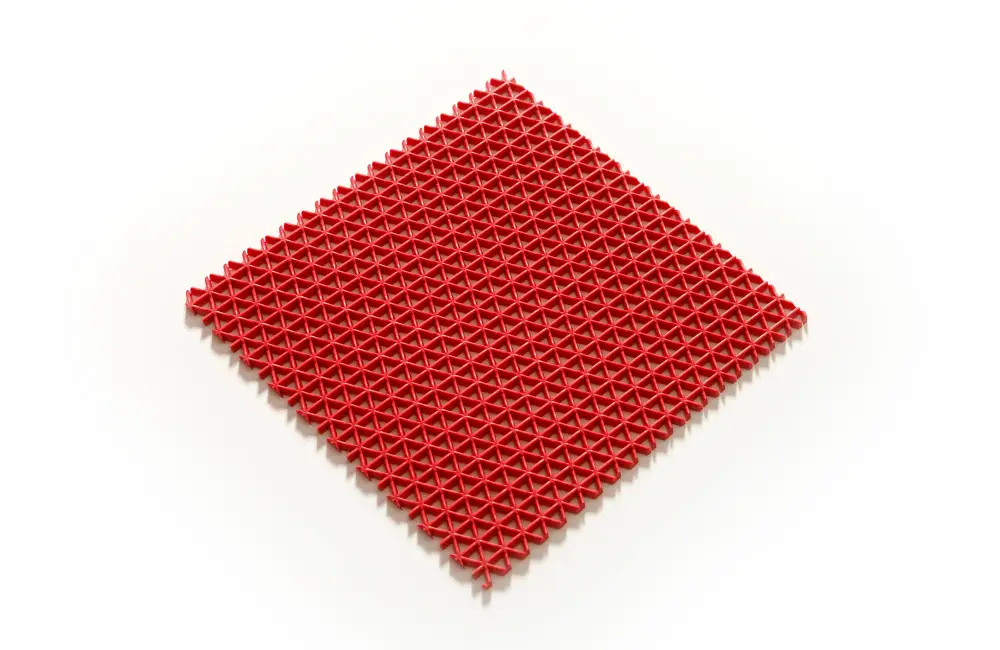
These are specially designed pads that can be placed under each leg of your furniture, providing extra grip and stability. Non-slip pads come in various sizes and shapes, making it easy to find one that fits perfectly under your couch legs.
To use non-slip pads, simply place them underneath each leg of your couch before positioning it on the hardwood floor. Make sure they are evenly spaced out so that weight distribution is balanced across all four legs.
Not only do these handy little accessories prevent slipping and sliding but they also protect both the flooring beneath as well as the bottom surface area of furniture from scratches or damage caused by friction between two surfaces rubbing against each other.
Rubber Stoppers
These stoppers come in various sizes and shapes, making them suitable for different types of furniture legs. They work by creating friction between the couch leg and the floor, preventing any unwanted movement.
To use rubber stoppers, simply place them under each leg of your couch or other furniture pieces that tend to slide around on hardwood floors. Make sure to choose stoppers that fit snugly under each leg so they don’t slip off easily.
One advantage of using rubber stoppers is their affordability and availability at most hardware stores or online retailers. They’re also easy to install without requiring any special tools or skills.
However, keep in mind that rubber may leave marks on some types of flooring over time if left in one spot for too long.
Rubber Padding
It’s easy to install and provides a strong grip that keeps furniture in place. Rubber padding comes in various sizes, so you can choose the one that best fits your couch legs.
To use rubber padding, simply measure the size of each leg and cut out pieces of rubber padding accordingly. Then, attach them to the bottom of each leg using adhesive or double-sided tape.
One advantage of using rubber padding is its durability; it lasts longer than other non-slip solutions like felt pads or grippers. It doesn’t leave any residue on your floors when removed.
Wall Spacers

These spacers can be easily installed between the wall and the back of your couch to prevent any unwanted movement. They work by creating a barrier that keeps your furniture in place, even when you’re sitting or moving around on it.
To install wall spacers, simply measure the distance between the back of your couch and the wall, then purchase appropriately sized spacers from a hardware store or online retailer. Once you have them in hand, slide them into place behind each leg of your sofa until they fit snugly against both surfaces.
While this method may require some extra effort compared to other non-slip solutions like furniture grippers or rubber stoppers, it’s an excellent option if you want something more permanent that won’t need constant readjustment over time.
Furniture Leg Coasters
These small, circular pads can be placed under the legs of your furniture and provide an extra layer of grip between the couch and the floor. Furniture leg coasters come in various materials such as rubber, felt or cork that will not only keep your furniture in place but also protect hardwood floors from scratches caused by moving furniture.
When choosing which type of coaster to use for your couch, consider factors like durability and thickness. Thicker coasters tend to offer better stability while thinner ones may wear out faster over time.
It’s important to note that using these coasters won’t completely eliminate all movement but it will significantly reduce it making them a great option for those who want their living space safe without compromising style or comfort.
Make sure you choose appropriate size pads according to each leg diameter so they fit snugly underneath each one.
Area Rugs and Runners

These not only add an extra layer of protection for your floors, but they also provide a non-slip surface for furniture. Place the rug or runner underneath the front legs of your couch, ensuring that it’s large enough to cover the entire seating area.
This will help anchor down your furniture and prevent any unwanted movement.
In addition to preventing slips, adding an area rug can also enhance the overall look of your living space. Choose one that complements both your decor style and color scheme while providing functionality at the same time.
When selecting an area rug or runner, make sure it has a non-slip backing already attached so you don’t have to worry about purchasing additional materials separately.
Rugs
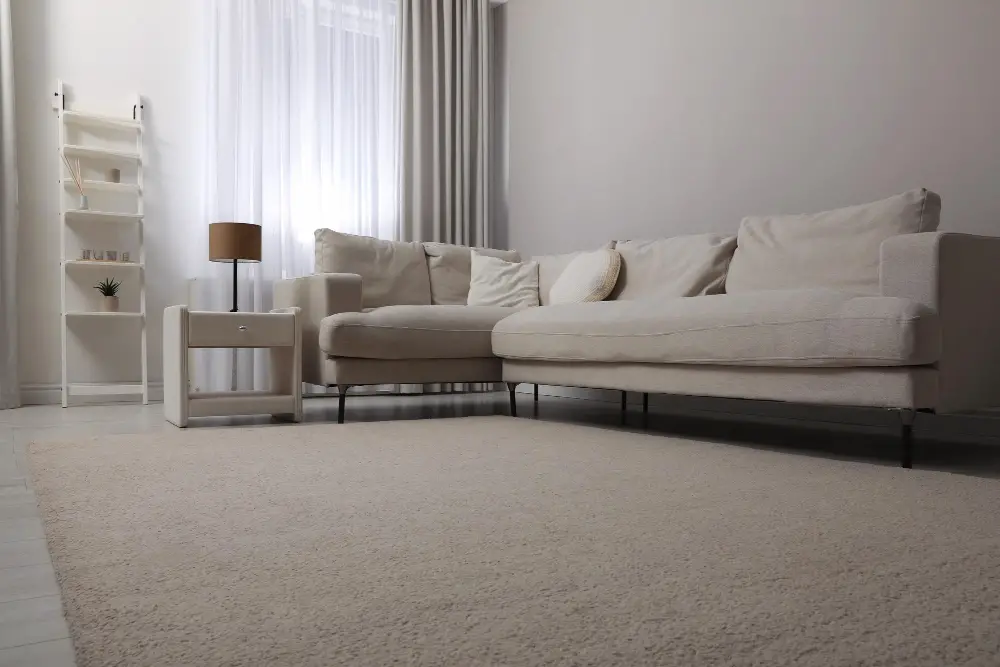
Placing an area rug or runner underneath the couch can provide extra grip and stability, keeping it in place even on the smoothest of surfaces. When choosing a rug for this purpose, make sure it’s large enough to accommodate both the couch and any accompanying furniture pieces such as coffee tables or side chairs.
Opt for rugs with non-slip backings or use rug pads underneath them for added security. Not only will this prevent slips and falls but also protect your hardwood floors from scratches caused by moving furniture around too often.
Stop Blocks
These small, wedge-shaped blocks can be placed under the legs of your furniture to prevent them from moving around. Stop Blocks come in various sizes and materials, including rubber and foam.
To use stop blocks, simply place them under each leg of your couch or other furniture piece that tends to slide around on hardwood floors. Make sure they are positioned correctly so that the weight of the furniture is evenly distributed across all four legs.
One advantage of using stop blocks is their affordability and ease-of-use compared to other non-slip solutions like grippers or pads. They also don’t require any installation time or special tools – just place them where you need them!
However, it’s important to note that while stop blocks can be an effective solution for preventing sliding on hardwood floors, they may not work as well if you have carpeting underneath your furniture legs.
Leg Felt
These felt pads are placed under the legs of your furniture, providing a soft and non-slip surface that prevents any unwanted movement. Leg felt is easy to install and can be found in most hardware stores or online retailers.
To use leg felt, simply clean the bottom of each leg with soap and water to remove any dirt or debris. Then, peel off the adhesive backing on each pad and firmly press it onto the bottom of each leg.
Make sure that all four legs have an equal amount of padding to ensure stability.
One advantage of using leg felt over other solutions like grippers or stop blocks is that they are virtually invisible once installed. This means you won’t have to sacrifice style for safety when it comes to your home decor.
DIY Solutions

One of the easiest and most effective methods is to use double-sided tape or Velcro strips. Simply attach them to the bottom of each leg of your couch and press firmly onto the floor.
Another option is using silicone caulk or hot glue gun under each leg, creating a non-slip surface that will hold up well over time. You can also try attaching rubber bands around each leg for added grip.
While these DIY solutions may not be as long-lasting as professional products, they can still provide an affordable temporary fix until you find a more permanent solution.
Remember that safety should always come first when it comes to furniture placement in any home.
Safety Precautions
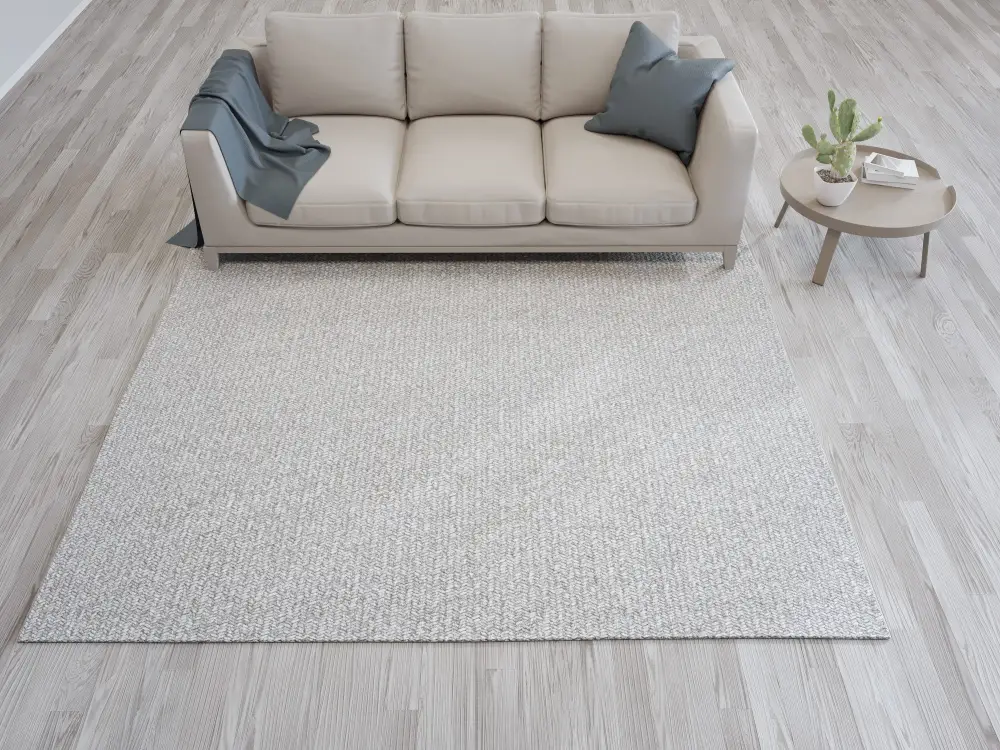
When implementing any of the solutions mentioned above, make sure to take necessary precautions to avoid accidents or damage. For instance, when using furniture grippers or non-slip pads under your couch legs, ensure that they are properly installed and secure before sitting on the furniture.
If you’re using rubber stoppers or padding between your couch and wall surfaces, make sure they don’t cause any damage by scratching or denting them.
It’s also essential to consider how these solutions may affect other aspects of your living space. For example: area rugs can add an extra layer of protection against slips but could pose a tripping hazard if not placed correctly.
Additional Tips

One of the most effective ways is to use double-sided tape or Velcro strips. Simply attach them to the bottom of your furniture legs and press firmly onto the floor for a secure grip.
Another tip is to place heavy objects such as books or weights on either side of your couch’s base. This will add extra weight and stability, preventing it from moving around too much.
Lastly, consider investing in slip-resistant socks or slippers for yourself and any guests who may be sitting on your couch. These can provide additional traction when walking around on hardwood floors, reducing slips and falls.
FAQ
How do I keep my couch from sliding on hardwood floors?
To prevent your couch from sliding on hardwood floors, use rubber or silicone pads under its legs, which are an inexpensive and effective solution.
How do I stop my furniture from shaking on my hardwood floors?
To stop your furniture from shaking on your hardwood floors, use furniture pads that can be nailed or applied with adhesive, providing a protective felt layer and rubber foam layer that keeps furniture stable and prevents movement.
What are some effective non-slip solutions to prevent couch movement on wooden surfaces?
Some effective non-slip solutions to prevent couch movement on wooden surfaces include using rubber pads, grip pads, or area rugs.
How can I protect my wood floors from damage caused by shifting furniture?
To protect your wood floors from damage caused by shifting furniture, use felt pads, furniture sliders, or rubber coasters under the furniture legs and avoid dragging items on the surface.
Which types of furniture pads or grippers are best suited for keeping couches stationary on hardwood floors?
The best types of furniture pads or grippers for keeping couches stationary on hardwood floors are non-slip rubber pads and silicone grippers.




